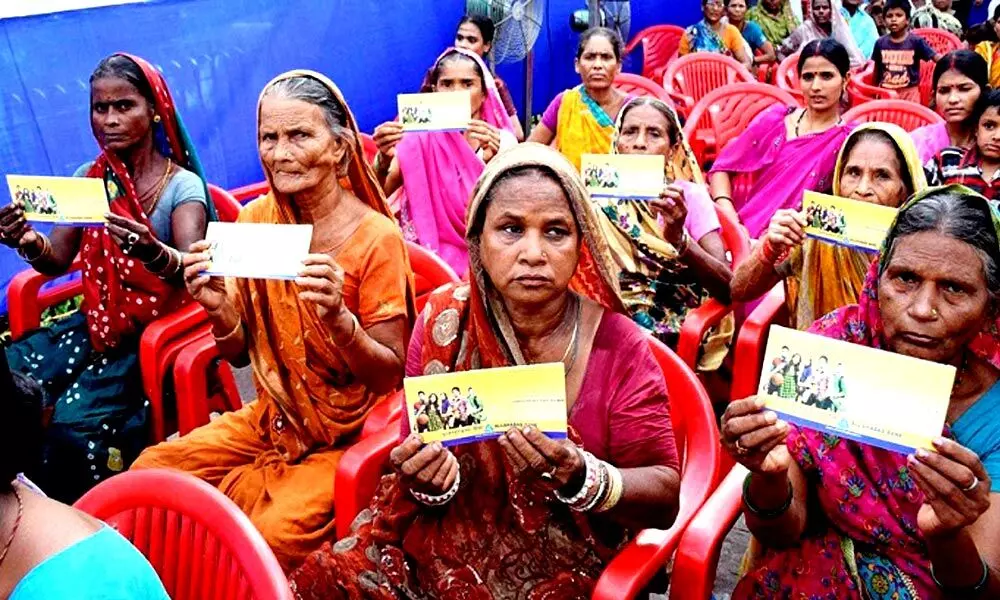States with higher balances in PMJDY accounts see decline in crime rate
India leaves behind Germany, China and South Africa in terms of number of bank branches per 1,00,000 adult population, says SBI report
image for illustrative purpose

India has stolen a march in financial inclusion with the initiation of PMJDY accounts since 2014, enabled by a robust digital infrastructure and also careful recalibration of bank branches and thereby using the Banking Correspondent (BC) model judiciously for furthering financial inclusion
Mumbai: The higher PMJDY accounts balances have seen a perceptible decline in crime. Also, sound financial inclusion policies have a multiplier effect on economic growth, reducing poverty and income inequality, while also being conducive for financial stability, says an internal research report by the country's largest lender, SBI.
India has stolen a march in financial inclusion with the initiation of PMJDY accounts since 2014, enabled by a robust digital infrastructure and also careful recalibration of bank branches and thereby using the Banking Correspondent (BC) model judiciously for furthering financial inclusion. Such financial inclusion has also been enabled by use of digital payments as between 2015 and 2020, mobile and internet banking transactions per 1,000 adults have increased to 13,615 in 2019 from 183 in 2015, says an internal research report by the country's largest lender, SBI.
The number of bank branches per 1,00,000 adults rose to 14.7 in 2020 from 13.6 in 2015, which is higher than Germany, China and South Africa. "Our research also shows that states with higher PMJDY accounts balances have seen a perceptible decline in crime," says Dr Soumya Kanti Ghosh, SBI group's chief economic advisor.
Ghosh added, "We also observed that there is both statistically significant and economically meaningful drop in consumption of intoxicants such as alcohol and tobacco products in states where more PMJDY accounts are opened."
The BC model in India is enabled to provide a defined range of banking services at low cost and hence is instrumental in promoting financial inclusion. Interestingly, the new branch authorisation policy of 2017–which recognises BCs that provide banking services for a minimum of 4-hours per day and for at least 5-days a week as banking outlets has progressively obviated the need to set up brick and mortar branches. For example, the number of 'Banking Outlets in Villages-BCs' has risen from 34,174 in Mar'10 to 12.4 lakh in Dec'20. Such progress shows an impressive outreach of banking services through branchless banking.
However, the success of financial inclusion depends upon BCs who are micro-level entrepreneurs. As per RBI guidelines, under the BC Model, while a BC can work for more than one bank, at the point of customer interface, a retail outlet or a sub-agent of a BC shall represent and provide banking services of only one bank. Interoperability of transactions is permitted by RBI at the retail outlets or sub-agents of BCs (at the point of customer interface), subject to certain conditions. Herein lie the problem.
It is sometimes observed that there is no uniformity among the BCs across banks regarding adherence to the above guidelines. PSBs mostly follow 'Branch Led BC Model', while other banks follow 'Branch Less/Corporate BC model'. The BCs of PSBs extend basic banking services, including opening of accounts, from a fixed location under the oversight of specific bank branch. The BCs of other banks operate through 'Micro ATM/Kiosk Application on Mobile' and primarily provide fee-based financial services, viz. withdrawals and remittance services, using hand-held devices. This also adds to the bottom-line by way of interchange fee from the PSBs or remittance fee from PSB customers. As a typical example, BCs convert AePS ON-US transactions of one set of bank customers, to AePS OFF-US issuer transactions and also carry out multiple AePS ON-US and AePS OFF-US transactions on the primary bank application/software.
Data indicates that the share of OFF-US transactions in AePS increased from 4 per cent in Sep-16 to 51 per cent in Sep-21. Considering these facts, PSBs (that opened around 77 per cent of the PMJDY accounts) are now net payers of interchange fee. We estimate that the PSBs could be paying around Rs 600-700 crore per annum as interchange fee. The report has made certain recommendations to make the BC model more rigorous and uniform across all banking entities.
Firstly, it recommends that as AePS works like a Point of Sales (PoS), logically the 'acquiring bank' should pay the interchange fee to the 'issuing bank'. Alternatively, there could be rationalisation in interchange fee as there is no level playing field in infrastructure provided by all banks. With requisite savings, banks can further strengthen/upgrade their BC model and promote financial inclusion in a more holistic manner.
Secondly, it has suggested RBI to disincentivise BCs who are converting the ON US transactions of PSB customers to AePS OFF US transaction in order to earn interchange fee and more commission. For this, it has proposed that a comprehensive database of BC agents be prepared through IBA's BC registry, JanDhan Dharshak App and RBI's CISBI portal. Additionally, we also propose that the log-in to the AEPS applications of the non-branch BC model must be through Aadhaar authentication. This will prevent anyone from logging and performing unverified transactions. This will also result in BCs and their friends and relatives not being able to game the system by opening accounts with multiple banks and performing round tripping/withdrawals, it says.
Indian economy is at the cusp of becoming a more efficient and formal one. We strongly believe some minor tweaks in the existing branch less BC model could act as a multiplier for promoting financial inclusion objectives. This is all the more important as we are currently formalising 34.7 crores of informal labour force through the E-Shram portal, the report adds.

